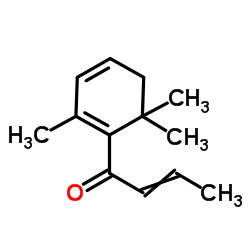

突厥烯酮结构式

|
常用名 | 突厥烯酮 | 英文名 | Damascenone |
|---|---|---|---|---|
| CAS号 | 23696-85-7 | 分子量 | 190.281 | |
| 密度 | 0.9±0.1 g/cm3 | 沸点 | 275.6±10.0 °C at 760 mmHg | |
| 分子式 | C13H18O | 熔点 | N/A | |
| MSDS | 中文版 美版 | 闪点 | 111.0±14.0 °C | |
| 符号 |


GHS02, GHS07 |
信号词 | Danger |
|
Instrumental and sensory approaches for the characterization of compounds responsible for wine aroma.
Chem. Biodivers. 5(6) , 1170-83, (2008) More than 800 aromatic compounds have been identified in wine, some of them at the ng/l level. Wine, therefore, constitutes a very complex matrix, from which it is difficult to isolate a specific aroma character. Gas chromatography-olfactometry (GC-O) applied... |
|
|
Identification and quantification of aroma-active components that contribute to the distinct malty flavor of buckwheat honey.
J. Agric. Food Chem. 50(7) , 2016-21, (2002) Characteristic aroma components of buckwheat honey were studied by combined sensory and instrumental techniques. Relative aroma intensity of individual volatile components was evaluated by aroma extract dilution analysis (AEDA) of solvent extracts and by gas ... |
|
|
Simultaneous determination of E-2-nonenal and beta-damascenone in beer by reversed-phase liquid chromatography with UV detection.
J. Chromatogr. A. 1032(1-2) , 17-22, (2004) A method for the simultaneous determination of E-2-nonenal and beta-damascenone in beer by reversed-phase liquid chromatography using UV detection is presented. The method consists of beer steam distillation, followed by an extraction/concentration step using... |
|
|
Use of solid-liquid distribution coefficients to determine retention properties of Porapak-Q resins. Determination of optimal conditions to isolate alkyl-methoxypyrazines and beta-damascenone from wine.
J. Chromatogr. A. 931(1-2) , 31-9, (2001) The solid-liquid distribution coefficients of different analytes--all of which are important aroma compounds--between hydroalcoholic solutions or wines and different sorbents have been determined by measuring the amount of analyte removed by a given mass of s... |
|
|
Volatile compounds responsible for aroma of Jutrzenka liquer wine.
J. Chromatogr. A. 1218(42) , 7566-73, (2011) Jutrzenka is a sweet liquer wine produced in Poland from the grape variety of the same name, developed in Poland to withstand the harsh climate of winery regions. Jutrzenka wine has a characteristic aroma with strong fruity and flowery notes, which make it un... |
|
|
Fate of damascenone in wine: the role of SO2.
J. Agric. Food Chem. 52(26) , 8127-31, (2004) Damascenone has been shown to undergo reaction with common wine components. Following the action of acid and heat alone, two bicyclic compounds, 4,9,9-trimethyl-8-methylenebicyclo[3.3.1]non-6-en-2-one (2) and 4,4,9-trimethyl-8-methylenebicyclo[3.3.1] non-6-en... |
|
|
A novel mechanism of filaggrin induction and sunburn prevention by β-damascenone in Skh-1 mice.
Toxicol. Appl. Pharmacol. 265(3) , 335-41, (2012) Understanding how oral administration of aroma terpenes can prevent sunburn or skin cancer in mice could lead to more effective and safer ways of blocking sun damage to human skin. To establish sunburn preventive activity, female Skh-1 mice were given oral β-... |
|
|
Fragrance material review on cis-beta-damascone.
Food Chem. Toxicol. 45 Suppl 1 , S192-8, (2007) A toxicologic and dermatologic review of cis-beta-damascone when used as a fragrance ingredient is presented. |
|
|
Fragrance material review on trans-beta-damascone.
Food Chem. Toxicol. 45 Suppl 1 , S199-204, (2007) A toxicologic and dermatologic review of trans-beta-damascone when used as a fragrance ingredient is presented. |
|
|
Identification of (3S, 9R)- and (3S, 9S)-megastigma-6,7-dien-3,5,9-triol 9-O-beta-D-glucopyranosides as damascenone progenitors in the flowers of Rosa damascena Mill.
Biosci. Biotechnol. Biochem. 66(12) , 2692-7, (2002) The progenitors of damascenone (1), the most intensive C13-norisoprenoid volatile aroma constituent of rose essential oil, were surveyed in the flowers of Rosa damascena Mill. Besides 9-O-beta-D-glucopyranosyl-3-hydroxy-7,8-didehydro-beta-ionol (4b), a stable... |